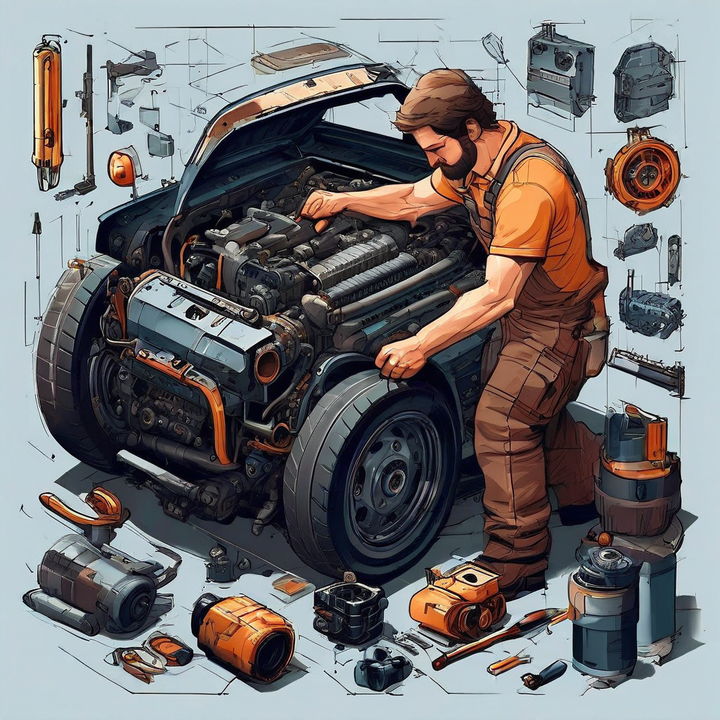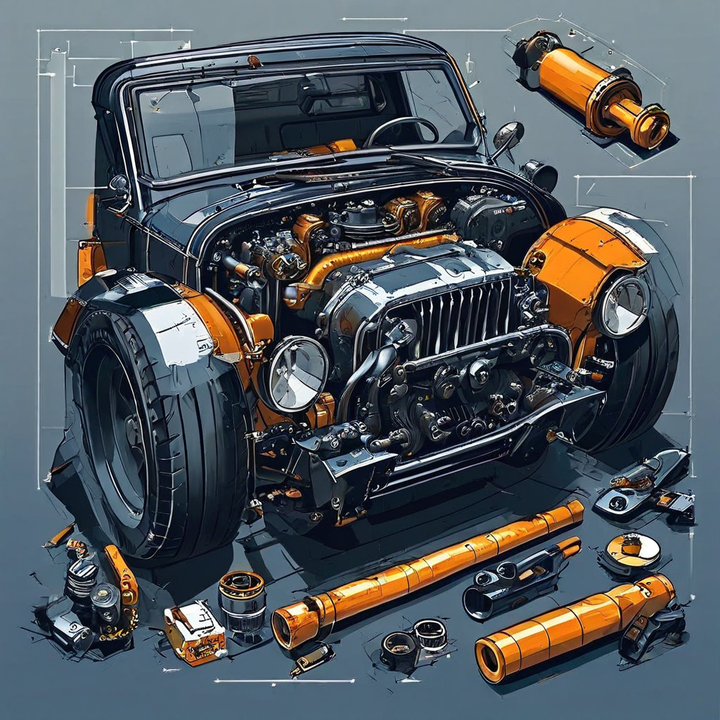


The diagnostic trouble code P03E3 indicates an issue with the pressure variation in cylinder 8 being too high. This code is related to the cylinder pressure sensor system and suggests that the combustion performance in cylinder 8 is abnormal.
Before we get our hands dirty, it's essential to understand the potential culprits behind the P03E3 code. Here are some of the most common causes:
| Cause | Description |
|---|---|
| Faulty Fuel Injector | If the fuel injector for cylinder 8 malfunctions, it can lead to inconsistent fuel delivery, resulting in pressure variations within the cylinder. |
| Leaking Fuel System Components | A leak in the fuel injector or the fuel pressure regulator can cause low fuel pressure, disrupting the air-fuel mixture and leading to pressure variations. |
| Vacuum Leaks | Any vacuum leaks in the intake system can wreak havoc on the air-fuel mixture, causing pressure variations in cylinder 8. |
| Exhaust Leaks | Leaks in the exhaust system, particularly near cylinder 8, can affect the combustion process and lead to pressure variations. |
| Worn Piston Rings or Cylinder Wall | If the piston rings or cylinder wall for cylinder 8 are excessively worn, it can cause compression issues and pressure variations. |
| Faulty Cylinder 8 Pressure Sensor | The pressure sensor for cylinder 8 itself may be malfunctioning, providing inaccurate readings and triggering the P03E3 code. |
Faulty Fuel Injector: The fuel injector plays a crucial role in delivering the precise amount of fuel required for combustion. If the fuel injector for cylinder 8 is not functioning properly, it can cause an inconsistent fuel delivery, leading to pressure variations.
Leaking Fuel Injector or Fuel Pressure Regulator: Even the smallest leak in the fuel system can have a significant impact on engine performance. Leaks in the fuel injector or the fuel pressure regulator can cause low fuel pressure, resulting in an improper air-fuel mixture and pressure variations.
Vacuum Leaks: Any vacuum leaks in the intake system can disrupt the air-fuel mixture, causing pressure variations in cylinder 8. These leaks can be tricky to locate, but they're a common culprit for various engine issues.
Exhaust Leaks: Leaks in the exhaust system, particularly near cylinder 8, can affect the combustion process, leading to pressure variations. These leaks can also cause other issues, such as decreased engine performance and increased noise levels.
Worn Piston Rings or Cylinder Wall: If the piston rings or cylinder wall for cylinder 8 is excessively worn, it can cause compression issues and pressure variations. This is often a sign of an aging engine or a lack of proper maintenance.
Faulty Cylinder 8 Pressure Sensor: In some cases, the pressure sensor for cylinder 8 itself may be malfunctioning, providing inaccurate readings and triggering the P03E3 code. This can be a tricky issue to diagnose, as the sensor may be the only component at fault.
Now that we've covered the potential causes, let's dive into the inspection and diagnosis process. Here are the steps I typically follow:
I always start with a thorough visual inspection. This includes:
Checking for any loose connections or damaged wiring to the cylinder 8 pressure sensor.
Inspecting the fuel injector for cylinder 8 and checking for any leaks or clogs.
To check for compression issues in cylinder 8, I perform a cylinder leakdown test. This test involves introducing compressed air into the cylinder and measuring the rate at which the pressure drops. If the pressure drops rapidly, it's an indication of worn piston rings or a damaged cylinder wall.
Next, I inspect the fuel pressure regulator and the entire fuel system for any leaks or pressure issues. Even a small leak can cause significant problems, so this step is crucial.
I carefully inspect the intake and exhaust systems, paying close attention to any vacuum or exhaust leaks near cylinder 8. These leaks can be challenging to locate, but they're often the root cause of pressure variations.
| Signs of Specific Issues | Description |
|---|---|
| Faulty Fuel Injector | Rough idle, misfiring, or poor acceleration when cylinder 8 is involved. |
| Vacuum Leaks | Whistling or hissing sounds from the engine, rough idle, and poor acceleration. |
| Exhaust Leaks | Loud exhaust noise, decreased engine performance, and potential check engine light. |
| Worn Piston Rings or Cylinder Wall | Low compression readings during the cylinder leakdown test, blue smoke from the exhaust, and potential oil consumption. |
| Faulty Pressure Sensor | Erratic or inconsistent readings from the sensor, even when other components are functioning correctly. |
During the inspection process, I also look for specific signs that can help pinpoint the issue, as outlined in the table above.
Once the root cause has been identified, it's time to roll up our sleeves and get to work. Here are the typical repair instructions for each potential issue:
| Issue | Repair Instructions |
|---|---|
| Faulty Fuel Injector | Replace the fuel injector for cylinder 8 following the manufacturer's instructions. This process involves carefully removing the old injector, ensuring proper sealing and alignment, and installing the new component. |
| Leaking Fuel System Components | Repair or replace the leaking component, and check the fuel system for any additional leaks or damage. |
| Vacuum Leaks | Locate and repair any vacuum leaks in the intake system, replacing damaged hoses, gaskets, or components as needed. |
| Exhaust Leaks | Locate and repair any exhaust leaks near cylinder 8, replacing gaskets, exhaust manifolds, or other components as required. |
| Worn Piston Rings or Cylinder Wall | In severe cases, an engine overhaul or cylinder replacement may be necessary to restore proper compression. |
| Faulty Pressure Sensor | Replace the cylinder 8 pressure sensor following the manufacturer's instructions. |
Always follow the recommended torque specifications when reassembling components.
Ensure proper sealing and alignment of gaskets and components to prevent future leaks.
Consider replacing related components (e.g., spark plugs, ignition coils) if they are due for maintenance.
While repairs are essential, prevention is always the best approach. Here are some tips to help prevent the recurrence of the P03E3 code and other engine issues:
Regular Maintenance: Follow the manufacturer's recommended maintenance schedule for engine components, fuel system, and ignition system.
Proper Usage and Operation:
Avoid excessive idling
Avoid aggressive driving
Avoid overloading the engine
These practices can accelerate wear and tear on various components, including the fuel system, intake, and exhaust systems.
Fuel Quality: Use high-quality fuel and consider using fuel system cleaners periodically to prevent buildup and clogs.
Regular Inspections: Regularly inspect the engine, fuel system, and exhaust system for any signs of leaks, wear, or damage, and address issues promptly.
The cost of repairing the P03E3 code can vary significantly depending on the underlying cause and the extent of the repair required. Here are some approximate cost ranges to give you an idea:
| Repair | Cost Range |
|---|---|
| Fuel Injector Replacement | $200 - $500 (including parts and labor) |
| Fuel Pressure Regulator Replacement | $150 - $400 |
| Vacuum Leak Repair | $100 - $300 (depending on the component needing replacement) |
| Exhaust Leak Repair | $200 - $800 (varies based on the exhaust component) |
| Piston Ring or Cylinder Replacement | $1,500 - $4,000 (for an engine overhaul) |
| Pressure Sensor Replacement | $100 - $300 |
Keep in mind that these costs are estimates and can vary based on your vehicle's make, model, and labor rates in your area. It's always recommended to consult with a professional mechanic for an accurate diagnosis and cost estimate specific to your vehicle.
The P03E3 code may seem daunting at first, but with the right knowledge and approach, it's a challenge that can be overcome. By understanding the potential causes, following proper inspection procedures, and executing the necessary repairs, you can restore your engine's performance and prevent further issues.
Remember, prevention is key. Regular maintenance, proper usage, and vigilant inspections can go a long way in avoiding costly repairs and ensuring your vehicle's longevity.
If you ever find yourself facing the P03E3 code or any other automotive issue, don't hesitate to seek professional assistance. A skilled mechanic can provide valuable insights, accurate diagnoses, and expert repairs, ensuring your vehicle remains in top condition.
Happy motoring, and may the road ahead be smooth and trouble-free!
The P03E3 code indicates a high pressure variation detected in cylinder 8 of the engine.
Common causes include a faulty fuel injector, leaking fuel system components, vacuum leaks, exhaust leaks near cylinder 8, worn piston rings or cylinder wall, and a faulty cylinder 8 pressure sensor.
Perform a visual inspection, cylinder leakdown test, fuel system inspection, and check for specific signs like rough idle, misfiring, or decreased performance.
Repair instructions may involve replacing the faulty component, such as the fuel injector, repairing leaks, or in severe cases, an engine overhaul or cylinder replacement.
Follow regular maintenance schedules, use high-quality fuel, avoid aggressive driving, and regularly inspect the engine, fuel system, and exhaust system.
The cost can vary significantly, ranging from $100 for a sensor replacement to $4,000 for an engine overhaul, depending on the underlying cause.
Yes, a faulty spark plug on cylinder 8 can cause the P03E3 code by affecting the combustion process and leading to pressure variations.
Yes, the P03E3 code is associated with other cylinder misfire codes, such as P0300 to P0312, which indicate misfires in different cylinders.
Yes, although less common, a mechanical issue like a bad valve or a leaking head gasket on cylinder 8 can also cause the P03E3 code.
Yes, it is recommended to address the P03E3 code promptly, as ignoring it can lead to further damage, such as catalytic converter failure or internal engine issues.

Miguel started tinkering with car radios as a teenager, fascinated by the intricate dance of wires and circuits. This passion led him to pursue a career as an automotive electrician. For the past 10 years, Miguel has tackled everything from flickering headlights to mysterious electrical gremlins. He thrives on troubleshooting electrical problems and enjoys sharing his knowledge to empower car owners to understand their vehicles better.



